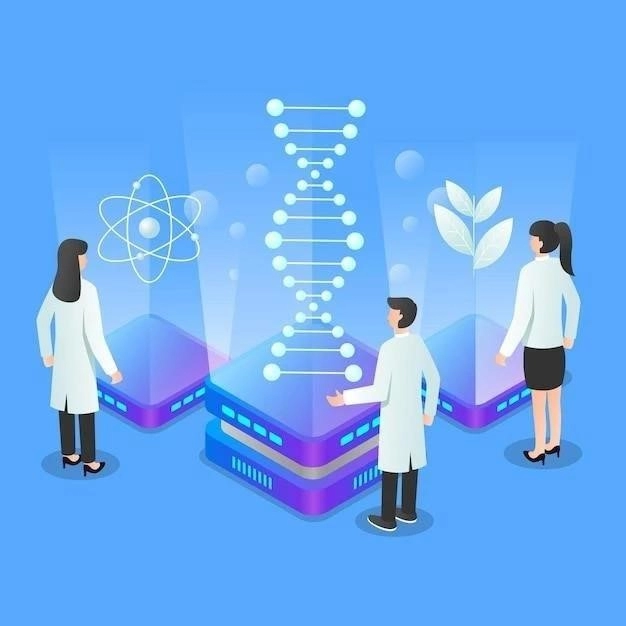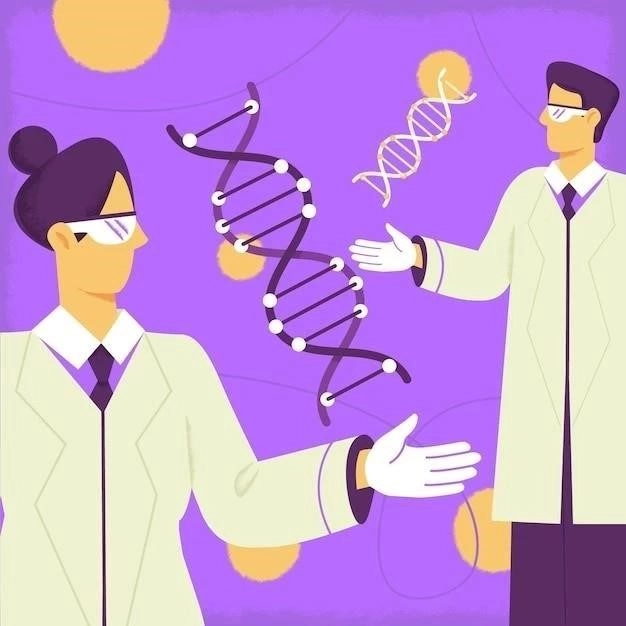In the realm of scientific exploration, few discoveries have been as groundbreaking as the unraveling of the structure and function of deoxyribonucleic acid, more commonly known as DNA. This elegant molecule, residing within the nucleus of almost every cell in our bodies, holds the blueprint of life—the genetic instructions that dictate our traits, characteristics, and even predispositions to certain diseases. This article delves into the fascinating world of genetics, exploring the intricacies of DNA and its profound impact on our existence.
A Historical Perspective
The story of DNAs discovery is a testament to scientific curiosity and collaboration. While the existence of DNA was first reported in 1869 by Swiss chemist Friedrich Miescher, its significance as the carrier of genetic information remained elusive for decades. It wasnt until the mid-20th century that the scientific community began to unravel the mysteries of this remarkable molecule.
In 1953٫ James Watson and Francis Crick٫ working at the University of Cambridge٫ made a monumental breakthrough. Drawing upon X-ray diffraction images of DNA captured by Rosalind Franklin and Maurice Wilkins٫ they deduced the molecules double helix structure. This groundbreaking revelation٫ which earned Watson٫ Crick٫ and Wilkins the Nobel Prize in Physiology or Medicine in 1962٫ marked a turning point in the history of biology٫ paving the way for a new era of genetic research.
The Structure of DNA: A Molecular Masterpiece
DNAs structure is often likened to a twisted ladder, a remarkably apt analogy. The two sides of the ladder are formed by alternating sugar (deoxyribose) and phosphate molecules, creating a sturdy backbone. Projecting inward from this backbone are the nitrogenous bases, the “rungs” of the DNA ladder. There are four types of bases: adenine (A), thymine (T), guanine (G), and cytosine (C).
The beauty of DNAs structure lies in its simplicity and elegance. The bases are not arranged randomly; rather, they pair up in a highly specific manner: adenine always pairs with thymine (A-T), and guanine always pairs with cytosine (G-C). This complementary base pairing is governed by hydrogen bonds, weak chemical forces that hold the two DNA strands together.
The Genetic Code: Language of Life
The sequence of these four bases along the DNA molecule constitutes the genetic code, a language that cells can read and interpret. This code contains the instructions for building and operating an organism, much like the lines of code in a computer program. Each gene, a specific segment of DNA, provides the blueprint for a particular protein. Proteins, in turn, are the workhorses of the cell, carrying out a wide range of functions, from catalyzing metabolic reactions to transporting molecules across cell membranes.
DNA Replication: Passing on the Blueprint
One of the most remarkable properties of DNA is its ability to replicate itself with astonishing fidelity. This process is essential for life, ensuring that the genetic information is passed on from one generation to the next. During replication, the DNA molecule unwinds, and the two strands separate, each serving as a template for the synthesis of a new complementary strand. The end result is two identical DNA molecules, each containing one original strand and one newly synthesized strand.
From Genes to Traits: The Flow of Genetic Information
The journey from gene to trait is a fascinating one, involving two main steps: transcription and translation. During transcription, the DNA sequence of a gene is copied into a messenger RNA (mRNA) molecule. This mRNA molecule then travels out of the nucleus and into the cytoplasm, where it encounters ribosomes, the protein synthesis machinery of the cell.
Ribosomes read the mRNA sequence and use it as a template to assemble amino acids into a polypeptide chain. The order of amino acids in the polypeptide chain is dictated by the sequence of bases in the mRNA, which in turn reflects the original DNA sequence of the gene; The polypeptide chain then folds into a specific three-dimensional structure, forming a functional protein.
Genetic Variation: The Source of Diversity
The sequence of DNA bases is remarkably similar among individuals of the same species. However, subtle variations in this sequence, known as genetic variations, are responsible for the vast diversity of life on Earth. These variations can arise from mutations, changes in the DNA sequence that can occur spontaneously or as a result of exposure to certain environmental factors.
Genetic variations can have a wide range of effects, from being harmless to causing diseases. Some variations may confer an advantage in a particular environment, increasing an individuals likelihood of survival and reproduction. Over time, these beneficial variations can become more common in a population, driving the process of evolution.

The Human Genome Project: Mapping Our Genetic Landscape
In 1990, the scientific community embarked on an ambitious endeavor: the Human Genome Project. The goal of this international effort was to determine the complete sequence of the human genome, the entire set of genetic instructions found in a human cell. After more than a decade of intense work, the project was completed in 2003, providing us with a blueprint of our own genetic makeup.
The completion of the Human Genome Project has had a profound impact on medicine and biomedical research. It has accelerated the discovery of genes associated with diseases, paving the way for the development of new diagnostic tools and therapies. Furthermore, it has opened up new avenues for understanding the complexities of human evolution and migration patterns.
Genetic Engineering: Shaping the Future of Life
Advances in our understanding of DNA have led to the development of powerful tools for manipulating genetic material. Genetic engineering, the ability to alter an organisms DNA, has revolutionized fields such as medicine, agriculture, and environmental science.
In medicine, genetic engineering is being explored as a potential approach to treating a wide range of diseases, from inherited disorders to cancer. Gene therapy, for example, involves introducing a functional copy of a gene into a patients cells to correct a genetic defect. In agriculture, genetic engineering is used to develop crops that are more resistant to pests, diseases, and harsh environmental conditions.

Ethical Considerations: Navigating Uncharted Territory
The rapid pace of advancements in genetic research raises profound ethical and societal questions. The ability to manipulate the very essence of life has sparked debates about the potential consequences of such interventions. Issues surrounding genetic privacy, informed consent, and the equitable distribution of benefits arising from genetic technologies require careful consideration and thoughtful dialogue.
Conclusion: A Journey of Discovery
The science of genetics, fueled by the discovery of DNAs structure and function, has illuminated our understanding of life in unprecedented ways. From unraveling the secrets of heredity to developing groundbreaking medical therapies, the impact of this field is undeniable. As we continue to explore the vast complexities of the genome, we can expect even more transformative discoveries that will shape the future of medicine, agriculture, and our very understanding of what it means to be human.
Beyond the Blueprint: Epigenetics and the Symphony of Gene Expression
While the discovery of DNAs structure and the sequencing of the human genome were monumental achievements, we now understand that the “blueprint” analogy of DNA is an oversimplification. The field of epigenetics has revealed a dynamic layer of control atop the static sequence of DNA, adding nuance and complexity to our understanding of gene regulation.
Epigenetics refers to heritable changes in gene expression that occur without alterations to the underlying DNA sequence. These changes are mediated by chemical modifications to DNA and its associated proteins, influencing how accessible genes are to the cellular machinery responsible for transcription. Like a conductor guiding an orchestra, epigenetic marks orchestrate the expression of our genes, determining which instruments (genes) are played, their volume, and their duration.
One well-studied epigenetic mechanism is DNA methylation, the addition of a methyl group to a cytosine base. This modification typically acts as a silencing mark, repressing gene expression. Another key player is histone modification, chemical alterations to the histone proteins around which DNA is wrapped. These modifications can either enhance or repress gene expression, depending on the specific mark and its location.
Environmental factors, such as diet, stress, and exposure to toxins, can influence epigenetic patterns, leading to changes in gene expression. Remarkably, some of these epigenetic changes can be passed down to future generations, providing a potential mechanism for the inheritance of acquired traits.
The Promise of Personalized Medicine
The convergence of genomics and epigenetics is ushering in an era of personalized medicine, where healthcare is tailored to an individuals unique genetic and environmental profile. By analyzing an individuals DNA sequence, gene expression patterns, and epigenetic marks, clinicians can gain insights into their susceptibility to diseases, their likely response to medications, and their overall health trajectory.
Pharmacogenomics, a field that examines how genetic variations influence drug response, holds immense promise for optimizing drug selection and dosage, minimizing adverse reactions, and maximizing therapeutic efficacy. Similarly, epigenetic biomarkers are being investigated as potential tools for early disease detection, monitoring disease progression, and predicting treatment response.
The Ethical Imperative: Navigating a New Era of Genetic Responsibility
As we delve deeper into the intricacies of the genome and harness the power of genetic technologies, we must proceed with caution and foresight. Ethical considerations surrounding genetic testing, data privacy, genetic discrimination, and access to genetic information require careful consideration and thoughtful dialogue.
The knowledge we gain from genetics has the potential to revolutionize healthcare, enhance food security, and deepen our understanding of life itself. However, we must ensure that these powerful tools are used responsibly, ethically, and equitably, for the benefit of all humankind.
Heres a continuation of your text, delving deeper into advanced concepts while maintaining a professional and formal tone:
Beyond Single Genes: Understanding Complex Traits and Genetic Networks
While the identification of single genes responsible for Mendelian disorders represented a major breakthrough, it has become increasingly clear that most human traits and diseases are far more complex. Height, intelligence, and susceptibility to chronic diseases like diabetes and heart disease are influenced by a intricate interplay of numerous genes, each with subtle effects, interacting with environmental factors.
Unraveling these complex genetic architectures requires sophisticated statistical methods like genome-wide association studies (GWAS). GWAS analyze millions of genetic variants across the genomes of thousands of individuals to identify subtle correlations between specific genetic variations and a particular trait. These studies have successfully pinpointed genetic loci associated with a wide range of complex traits, providing valuable insights into their underlying biology.
Furthermore, our understanding of gene regulation has extended beyond the linear sequence of DNA to encompass the intricate three-dimensional organization of the genome. The spatial arrangement of chromosomes within the nucleus plays a crucial role in gene expression, with distant regulatory elements influencing the activity of target genes through looping interactions.
The Microbiome: Expanding the Genetic Landscape
Our understanding of genetics has expanded beyond the confines of our own cells to encompass the trillions of microorganisms that reside within and upon us—the human microbiome. These microbial communities, primarily bacteria but also viruses, fungi, and archaea, play a crucial role in human health and disease.
The collective genome of the microbiome, known as the metagenome, dwarfs the size and complexity of our own genome. Researchers are only beginning to unravel the intricate interplay between our genes, our environment, and the genes of our microbial inhabitants. Early findings suggest that the microbiome influences a wide array of physiological processes, including digestion, immunity, metabolism, and even behavior.

The Future of Genetics: Towards Predictive and Precision Medicine
The ongoing revolution in genomic technologies, coupled with advances in data analysis and artificial intelligence, is poised to transform medicine in unprecedented ways. Large-scale genomic sequencing initiatives, coupled with comprehensive health data, are enabling the development of powerful predictive models for disease risk, diagnosis, and treatment response.
Precision medicine, an approach that tailors healthcare to an individuals unique genetic, environmental, and lifestyle factors, is rapidly becoming a reality. This personalized approach promises to optimize disease prevention strategies, improve diagnostic accuracy, and guide the development of targeted therapies with minimal side effects.
As we continue to push the boundaries of genetic knowledge, we must remain mindful of the ethical and societal implications of these powerful technologies, ensuring that their benefits are accessible to all and used responsibly to advance human health and well-being.










